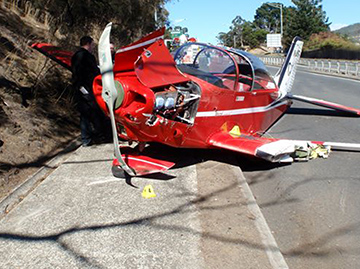- Fuel exhaustion happens when an aircraft runs out of usable fuel before the flight is finished.
- Fuel exhaustion occurrences are normally either the result of a gross error in the fuelling of an aircraft before flight, or the result of a number of seemingly minor aspects of fuel planning and management during the flight.

Accidents involving fuel exhaustion often happen close to the flight’s destination. If fuel exhaustion occurs when the aircraft is close to landing, it may offer the pilot less time and opportunity to successfully manage the situation.
In April 2010, the pilot of a light aircraft was conducting the fifth flight since refuelling, when the engine lost power while sight-seeing over Hobart, Tasmania. The pilot conducted a forced landing onto the Brooker Highway, resulting in substantial damage to the aircraft.
The pilot reported that he had used a dipstick to assess that there was sufficient fuel for the flight, and that the fuel quantity indicator provided a similar indication of fuel quantity, showing the tank was about half full. Unfortunately, the pilot used an incorrect (but not uncommon) method of using the dipstick that resulted in an over-reading of the fuel onboard. Furthermore, a close inspection of the aircraft’s flight and fuel log would have revealed that the fuel gauge and the dipstick indications showed a fuel usage that was half the expected usage.
What we found
The ATSB investigation AO-2010-025 found that the power loss was due to exhaustion of the aircraft's fuel supply and that a number of factors worked against the pilot, some of which were outside his control.
The amount of fuel on board should be thought of, not as a quantity, but as a flight time.
Cross-checking the dipstick reading against the fuel gauge indication was an effective method for spotting errors, however, a quick mental calculation would have shown a significant discrepancy between the indicated fuel quantity and the expected fuel usage. The discrepancy could have alerted the pilot that something was wrong with the available fuel quantity information.
Safety message
Certain types of flight regularly carry just enough fuel for the flight, with little margin. Flying schools and gliding towing operations may only refuel aircraft after two or three flights, so the last flight before refuelling can have less fuel margin. Charter operations may be flying with minimum fuel required because a flight’s profitability will depend on carrying the maximum payload, which means no unnecessary fuel be carried. Such operations will be more vulnerable to any inaccuracies in the pilot’s knowledge about the amount of fuel on board. However, fuel exhaustion accidents and incidents occur in all types of aviation operations. They are normally related to a lack of awareness of information that is readily available at the pre-flight planning stage. This includes both the amount of fuel on board, and the rate of fuel consumption.
The chance of fuel exhaustion is reduced if the pilot accurately determines the amount of fuel on board prior to starting. This should entail the use of a fuel quantity cross-check using a number of sources, including:
- fuel quantity gauges
- dipsticks
- flowmeters/ totalisers
- calculations from previous refuels and fuel usage, (regularly checked for accuracy).
Fuel exhaustion happens when there is no useable fuel remaining to supply the engine(s).
The amount of fuel on board should be thought of, not as a quantity, but as a flight time. For a consistent combination of altitude, power setting and mixture setting, the fuel burn will be constant, but changing winds and deviations due to weather conditions will vary the groundspeed and therefore the range. Your fuel status should be regularly updated, at least every hour, to ensure you maintain an adequate reserve1.
An aircraft that is carrying only just enough flight fuel2 for the planned flight, but which encounters unanticipated headwinds and perhaps has to fly at a lower level is eating into its fuel reserves. Those reserves are there to be used in unforeseen circumstances and many aircraft arrive safely at their destination having used a portion of the allocated reserve fuel. However an aircraft’s fuel supply should not reach a state where, upon arriving at its destination, it can accept no further delay.
Learn more about fuel management aviation accidents
Read the report: Total power loss - Victa Airtourer, VH-MTC, Hobart, Tasmania, on 4 April 2010
___________
1. Reserve fuel refers to the required fuel, in addition to flight fuel, that is not planned for normal use, but remains available for unplanned events where all other useable fuel has been consumed. This fuel is to be used only when there is no other safer alternative.
2. Flight fuel refers to all the fuel that is expected to be used during the planned flight, including holding fuel and fuel for planned diversions.
Conclusion
Fuel exhaustion is more likely to occur on flights when there is little flight fuel margin, that is, landing with just reserve fuel on board. In these circumstances, particular attention to detail in fuel management is warranted. The chance of fuel exhaustion can be reduced by:
- using more than one source of information to obtain consistent results about the fuel on board before flight
- the use of a consistent procedure that is regularly checked to know the exact rate of fuel consumption
- monitoring the flight to ensure that sufficient fuel will remain on board in the event of unplanned delays.


